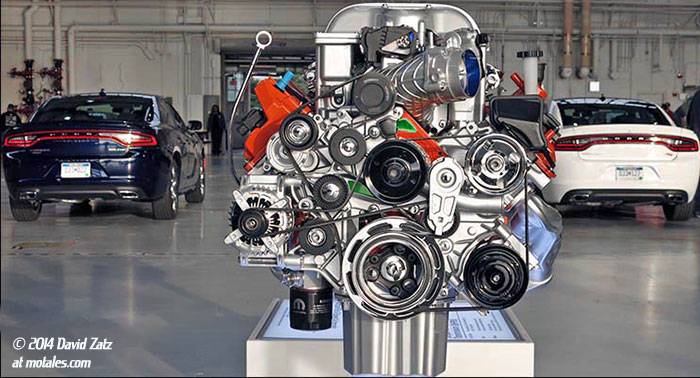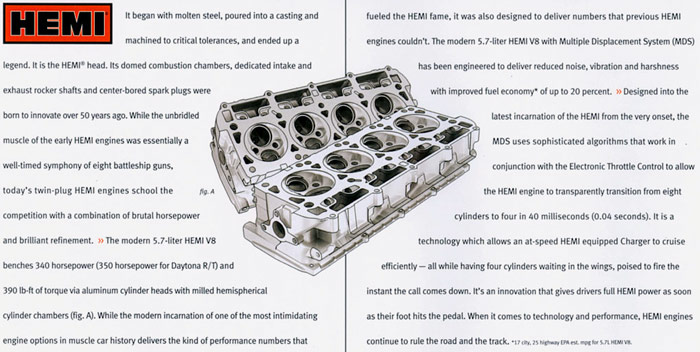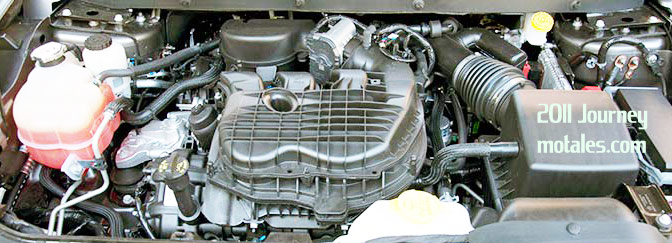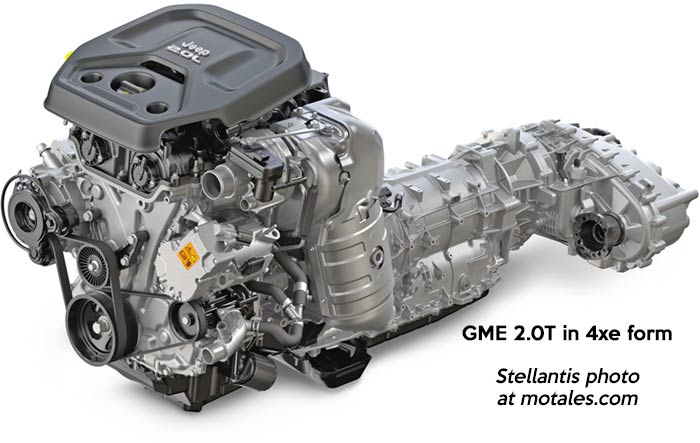In 2023, Chrysler built its last 5.7 liter Hemi V8 and 6.2 liter supercharged “Hellcat.” The Mexican assembly lines had produced a stockpile of V8s for the Dodge Durango and Ram 1500 Classic, while the 2025 Ram switched to twin-turbo six-cylinder engines, which had better gas mileage, did not require 89-octane fuel, and generated more power.

Across social media and the remaining traditional forums, though, customers and fans demanded the return of their beloved Hemi. (Ram does still make one V8, the truck 6.4, which is only used in the Ram 2500 and 3500.)
The V8 hard-core want a V8, and nothing else will do. Their reasons vary: the sound, not wanting an “overstressed” engine, not trusting complex twin-turbos, and just demanding a V8 because that’s what they want. Dodge and Ram spent years telling people they needed a Hemi, right up to the point they didn’t have one to sell. Jeep people were not as emphatic, possibly because their key product, the Wrangler, was mainly sold with a V6.
Incidentally, the 2025 Dodge Durango is still sold with the 5.7 Hemi and Hellcat as options... in case you really wanted a new Hemi car, it’s there.
Moving on, there are four possible ways for a new V8 to show up at Stellantis:The least likely route may actually be making the old Hemi V8s again. This is admittedly more likely than it was before people started talking seriously about the EPA being de-funded. Still, the 5.7 Hemi has had some long-term durability issues, requires midgrade (89 octane) fuel, and it is not as competitive as it was years ago—and GM is working on a completely new V8. The 6.4, on the other hand, has 485 hp and instant-on torque, and remains quite strong overall, albeit not ideal for everyone with its premium fuel requirement.
There is a big obstacle to either of them: the machinery is being used for the Hurricane Six, and their more unique tooling may not be usable or available. Stellantis, in full cost-cutting mode, is unlikely to chance this kind of cost to duplicate an existing engine’s market position. This is an objection that applies to any of the options in this story—except one.

Back in 2018, according to Allpar’s JDM, the engines team was doing pre-development work on upgrades to the 5.7 Hemi to increase fuel economy; its code name was originally Warthog, after the fighter, but after the PR group got wind of that name, the team voted again and called it Hercules after the cargo plans that could be converted to offensive use. JDM wrote that no one particular problem killed the engine; it was the total cost to retool, overcome emissions issues, and possible issues with “flat map” or “lambda 1” behavior, with fuel enrichment assumed to be off the table. Other engine options were deemed better. This is also when simulations determined that a 7-liter, 426 cubic inch Hemi would be ideal for big trucks, but that was likely a non-starter due to cost. Regardless, if a new assembly line were to be set up, some of the changes to the 5.7 could be put into place—but it would take at least two years, likely longer. The same would be true for a bigger truck engine.
The Dodge Charger is still set to get a gasoline engine, but it will be the twin-turbo straight six, most likely rated at 540 hp in high output form—around 55 hp more than the 6.4 Hemi V8. Chances are the executives are thinking V8 purists will come around sooner or later.
The easiest option would be to bring the 6.4 liter engine to the Ram 1500; it produces roughly the power of the 5.7, with more torque, and lower fuel economy. This would be a limited run engine sold at a premium price despite the lower performance, and is only a sensible option if fuel-economy rules are rolled back so far Stellantis has extra ground; and if they can make enough of the engines to make a difference. The Ram 1500 sells at much higher rates than the bigger pickups and chassis cabs; chances are the 6.4 BGE line was not set up with enough extra capacity to crank out mainstream engines for the Ram 1500 as well. It is a relatively easy option, if it fits, and, again, if there’s no need to worry about gas mileage or emissions.
When the Pentastar V6 was new, the engineers also planned on a V8 version. At the time it was rumored to be 4.8 liters. This V8 would be around one liter of displacement smaller than the Hemi and might not be ideal for trucks. Still, a Pentastar V8 could be a way to quickly put a V8 into production mostly using existing parts and facilities. Chances are it could reach roughly 380 hp, given that the Pentastar runs up to 310 hp, but power-per-liter gets harder as you make the engine bigger. Reaching 400 hp might take a serious effort, but it would break a psychological barrier. There’s also the possibility of keeping the gasoline engine at 360-380 hp, and supplementing it with an electric motor in the transmission.

We have no idea if the Pentastar V8 was ever actually built for testing. It may have simply been an idea. One would hope it had the correct V angle, unlike a V6-with-two-more-cylinders.
The question then is whether it would be tough enough for Ram 1500 duty, and the answer might not be “yes.”
As far as cost is concerned, a new block line would be needed, but many of the existing parts might be reusable. A new assembly line would be needed.
Some have brought up a Hurricane-based V8, but to do this in any reasonable amount of time, Stellantis would almost certainly need to keep the bore the same—doing otherwise would require a new head design, and that means a great deal of time testing new combustion chambers. That seems unlikely to come up, so we’re talking a little 4.0 liter engine.

There has been no 2.0 without a turbo, and dropping the turbocharger might also require changing the combustion chambers. But perhaps the objection to a turbo might not be so strong, if looking at a single turbocharger with a V8? It could be supplemented with a transmission-based electric motor to make up for its small displacement. Many of the parts might be shared with the GME 2.0 EVO or the original GME 2.0, but again, a new block line would be needed along with a great deal of new tooling. A great deal of tuning and durability testing and such would be needed, too. The massive, multi-year investment required is still a big issue for a constantly cost-cutting company.
Cummins started working on adapting some of its engines to work with different fuels years back; the project was reportedly abandoned for a while and then brought back with some key personnel changes, but whether these engines, converted from diesel to gasoline or hydrogen or CNG—the conversion is at the factory, so only one option is possible—are actually practical is an open question. Hydrogen internal combustion doesn’t seem to make much sense compared with hydrogen fuel cells, at least in cars that don’t require a commercial driver’s license (CDL). Cummins created a small V8 diesel, which Dodge was going to use in Ram pickups years back—but then Fiat took over and that project was dropped; Nissan picked it up. Conceivably that could be used in the Ram 1500, albeit as a diesel, but it seems unlikely, overly expensive, and possibly impractical. It’s not one of the engines Cummins planned to convert to gasoline. File this one in the “we had to bring it up, but we don’t really expect it” category, especially compared with the next option. (We might add that the famed Cummins B-engines, used in Ram trucks now, are turbocharged straight sixes.)
Stellantis would spend more per car/truck but avoid a massive capital investment by simply buying V8s.
GM is working on new V8s but may not want to share them; Ford and Toyota still make V8s, but with truck rivalries strong, none of these three options might work for Ram, because (a) the maker may not want to sell engines, and (b) customers might say “anything but ...”.
In-house, Stellantis makes no V8s. The Maserati V8 engines are purchased from Ferrari; they are twin turbo designs which are both expensive and an unlikely choice for pickups.
Outside Stellantis, Hyundai already dropped its Genesis V8 back in late 2021. Nissan only recently dropped its Titan V8, and doesn’t really compete against Ram. Its power ratings of 400 hp and 413 lb-ft were well over the 5.7 Hemi’s output. It may not be the solution a lot of V8 lovers want, but the most likely option for Stellantis would be the Nissan Titan engine. It would require no money down, it would probably be sold at the right price, and it’s already engineered for the pickups that would be its primary vehicle. It’s not turbocharged, “overstressed,” or a hybrid—it’s just a V8 producing around the same power as the “Eagle” Hemi V8. (To clarify, I personally am not endorsing this choice.)
If fuel economy standards were to suddenly disappear, this might be Stellantis’ solution for buyers unwilling to move on to the Hurricane—but it would not be the base engine, nor the cheapest option for buyers.
Copyright © 2021-2025 Zatz LLC • Chrysler / Mopar car stories and history.
YouTube • Editorial Guidelines • Videos